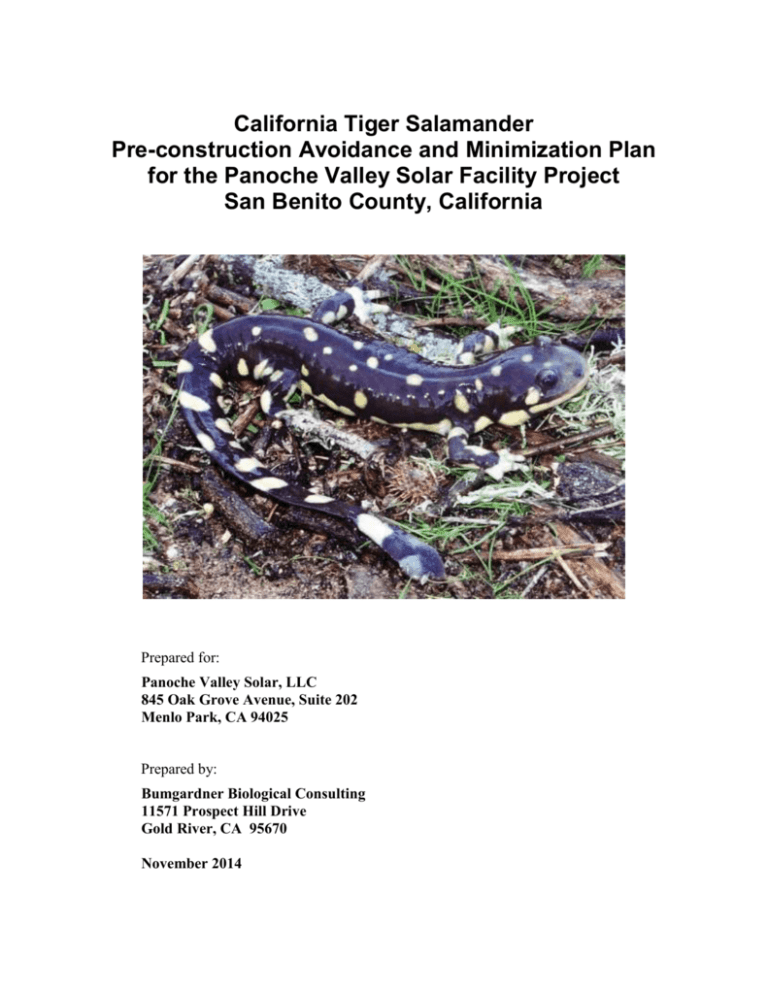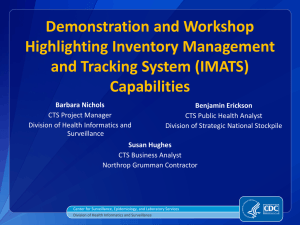20141103 Final Draft CTS Avoidance and Minimization Plan
advertisement

California Tiger Salamander Pre-construction Avoidance and Minimization Plan for the Panoche Valley Solar Facility Project San Benito County, California Prepared for: Panoche Valley Solar, LLC 845 Oak Grove Avenue, Suite 202 Menlo Park, CA 94025 Prepared by: Bumgardner Biological Consulting 11571 Prospect Hill Drive Gold River, CA 95670 November 2014 Introduction This Pre-construction Avoidance and Minimization Plan (Plan) has been prepared to establish the procedures for the potential salvage, handling, and relocation of California tiger salamander (Ambystoma californiense) (CTS) if encountered during pre-construction clearance surveys associated with the Panoche Valley Solar Farm Project (Project) in San Benito County, California (Figures 1 and 2). The Plan has been prepared pursuant to the mitigation measures in the Final Environmental Impact Report for the Panoche Valley Solar Farm Project (CUP No. UP 1023-09; State Clearinghouse No. 2010031008) (2010). It should be noted that this Plan precedes the U.S. Fish and Wildlife Service’s (USFWS) issuance of the Biological Opinion for the Project and California Department of Fish and Wildlife’s (CDFW) issuance of the California Fish and Game Code Section 2081 Incidental Take Permit (ITP) for the Project. As such, minor changes to this Plan may occur upon issuance of these documents. Legal Status The CTS population segment which occurs in the vicinity of the Project is currently listed as threatened under the California Endangered Species Act and federal Endangered Species Act. The Project does not contain USFWS designated critical habitat for CTS. In addition, no Recovery Plan has yet been prepared for the species. Species Ecology The CTS is a large, stocky, terrestrial salamander with a broad, rounded snout. Adults may reach a total length of 8.2 inches (Petranka 1998, Stebbins 2003). The CTS exhibits sexual dimorphism (e.g., males tend to be larger than females). As adults, CTS tend to have creamy yellow to white spotting on the sides that becomes much reduced on the dorsal surface of the animal, whereas other tiger salamander species have brighter yellow spotting that is heaviest on the dorsum. The species occurs from near sea level up to approximately 3,900 feet in the Coast Ranges and up to approximately 1,600 feet in the Sierra Nevada foothills (Shaffer et al. 2004). Along the Coast Ranges, the species occurred from the vicinity of Santa Rosa in Sonoma County to near Buellton in Santa Barbara County. In the Central Valley and surrounding foothills, the species occurred from northern Yolo County southward to northeastern Kern County and northern Tulare County. The CTS has an obligate biphasic life cycle (Shaffer et al. 2004). Although breeding, egglaying, and development of the larval salamanders occur in vernal pools and other ponds, the species otherwise spends most of its post-metamorphic life in widely dispersed, underground retreats (Trenham et al. 2001, Shaffer et al. 2004). Subadult and adult CTS spend the dry summer and fall months of the year in the burrows of small mammals (e.g., California ground squirrel (Otospermophilus beecheyi) and Botta’s pocket gopher (Thomomys bottae) (Storer 1925, Loredo and Van Vuren 1996, Petranka 1998, Trenham 1998a). These burrows provide protection from the sun and dry winds that are associated with the dry California climate. Given that CTS utilize burrows created by other species (rather than dig their own burrows) and these burrows typically collapse within 18 months if not maintained, an active population of burrowing mammals is necessary to sustain sufficient underground refugia for the species (Loredo et al. 1996). The burrows inhabited by CTS are not estivation sites. Studies have demonstrated that individuals move, feed, and remain active in their burrows during the summer months (Trenham 2001, Van Hattem 2004). Individuals may even move between closely located burrows (Trenham 2001). In addition, researchers have long inferred that individuals are feeding while underground since they arrive at breeding ponds in good condition and are heavier when entering the pond than when leaving the pond (Trenham 2001). Dispersal and migration movements made by adult CTS can be grouped into three categories: (1) postmetamorphosis dispersal; (2) breeding migration; and (3) interpond dispersal. After metamorphosis, juveniles move away from breeding ponds into the surrounding upland habitat, where they live continuously for several years. At a study in Monterey County, it was found that upon reaching sexual maturity, most individuals returned to their natal (i.e., birth) pond to breed. However, 20 percent of the individuals dispersed to other ponds where they breed (Trenham et al. 2001). Following breeding, adult CTS return to the upland habitat, where they may live for one or more years before breeding again (Trenham et al. 2000). CTS are known to travel relatively long distances from the breeding ponds into the surrounding upland habitat (something that is surprising given the small size of the species). Maximum distances moved are difficult to establish for the species, but an individual in Santa Barbara County was found approximately 1.3 miles from the nearest known breeding pond (S. Sweet in litt. 1998), suggesting that the species may be able to move up to distances of this magnitude. As previously mentioned, CTS are known to travel between breeding ponds. One study found that 20 to 25 percent of the individuals captured at one pond were later captured at other ponds approximately 1,900 and 2,200 feet away (Trenham et al. 2001). In addition to traveling long distances during breeding migrations or interpond dispersals, CTS may reside in burrows that are far from known breeding ponds. At one site in Contra Costa County, hundreds of CTS were captured 3 years in a row in upland habitat approximately 0.75 mile from the nearest known breeding pond (Orloff 2007). Although observations show that CTS may travel far from breeding ponds, individuals typically reside in upland habitat that is closer to the breeding ponds. Evidence suggests that juvenile CTS disperse further into upland habitats than adult CTS. A trapping study conducted in Solano County during winter of 2002–2003 found that juveniles used upland habitats farther from breeding ponds than adults did (Trenham and Shaffer 2005). More juvenile individuals were captured at distances of 328, 656, and 1,312 feet from a breeding pond than at 164 feet. Approximately 20 percent of total captures were found 1,312 feet from a breeding pond. Fitting the data to a distribution curve demonstrates that 95 percent of juvenile individuals could be found within 2,099 feet, with the remaining 5 percent being found at even greater distances. Preliminary results from the 2003–2004 trapping effort detected juvenile CTS at even greater distances, with a large proportion of the total CTS caught at 2,297 feet from the breeding pond (Trenham and Shaffer 2005). Surprisingly, most juveniles captured, even those at 2,100 feet, were still moving away from the ponds. Such variability in movements (particularly by juvenile CTS) may reflect a “hardwired” genetic behavior that increases the likelihood that a metapopulation will persist (particularly given the short and long-term ephemeral nature of vernal pool systems) if individuals travel longer distances where they may encounter other breeding ponds. This latter behavior and the known interpond dispersal behavior that has been demonstrated at some sites would appear to support this concept. Furthermore, interpond movements may also reduce local in-breeding depression, genetic drift, and founder effects that could occur if individuals only returned to their natal pond. Postbreeding movements away from breeding ponds by adults appear to be much smaller. During postbreeding emigration, radio-telemetered adult CTS were tracked to burrows 62 to 813 feet from their breeding ponds (Trenham 2001). These reduced movements may be due to adult CTS having depleted physical reserves after breeding or due to the drier weather conditions that often occur during the period when adults leave the ponds. The reduced movement may also reflect the effects of the internally-placed radio-telemeter on the physiology of the individual. However, the shorter movement distances of adult CTS may also reflect the selective advantages of only moving as far away from the breeding pond as necessary to find suitable refugia (such that more energy goes into reproduction and less into travel). Once CTS have moved into the surrounding upland habitat, most individuals use several successive burrows at increasingly greater distances from the pond. Although the studies discussed above provide an approximation of the distances that CTS move from their breeding ponds, movement in the upland habitat is believed to be driven by the local habitat features. Trenham (2001) found that radio-telemetered adults favored grassland with scattered large oaks over more densely wooded areas. A drift fence survey at a pond in Santa Barbara County found that many emigrating juveniles moved towards an adjacent strawberry field. However, no adults were captured returning to the pond from this direction. Nor did many CTS return to the pond from the direction of adjacent sandhill or eucalyptus habitats found in other quadrants. Most of the CTS returning to the pond were captured coming from a nearby, extensive overgrazed grassy flat (S. Sykes pers. comm. 2011). Furthermore, based on studies of radio-telemetered individuals, CTS do not appear to favor specific corridors for movement in the upland habitat (Trenham 2001). At two ponds completely encircled by drift fence and pit fall traps, captures of arriving adults and dispersing juveniles were distributed randomly around the ponds. Therefore, it appears that dispersal into the surrounding upland habitat occurs randomly with respect to direction and habitat types. Once the fall or winter rains begin, individuals emerge from their burrow (typically on rainy nights) to feed and migrate to the breeding ponds (Shaffer et al. 1993). Adult salamanders mate in the ponds, after which the females lay their eggs in the water (Twitty 1941, Shaffer et al. 1993, Petranka 1998). Historically, the CTS utilized vernal pools as breeding ponds. However, many current breeding sites also include stock ponds. Females attach their eggs singly, or in rare circumstances, in groups of two to four eggs to twigs, grass stems, other vegetation, or debris (Storer, 1925, Twitty 1941). In ponds with no or limited vegetation, they may be attached to objects such as rocks and boards that are located on the pond bottom (Jennings and Hayes, 1994). After breeding, adults leave the pond and enter small mammal burrows (Loredo et al. 1996, Trenham 1998a) where they may continue to exit and enter the burrows nightly for the next few weeks to feed (Shaffer et al. 1993). It should be noted that in drought years the seasonal ponds may not fill, and adults do not breed (Barry and Shaffer 1994). CTS eggs hatch in 10 to 14 days, with newly hatched larvae ranging from 0.45 to 0.56 inch in total length (Petranka 1998). The larvae are entirely aquatic. They often rest on the bottom in shallow water, but may also be found at different depths in the water column in deeper water. The larvae are wary and when approached by potential predators, they dart into vegetation on the bottom of the pond (Storer 1925). The larval stage of the CTS usually lasts 3 to 6 months as most seasonal ponds dry completely during the summer months (Petranka 1998). Amphibian larvae must develop to a critical minimum body size before they can metamorphose to the terrestrial stage (Wilbur and Collins 1973). Individuals collected near Stockton in the Central Valley during April varied from 1.88 to 2.32 inches in length (Storer 1925). Feaver (1971) found that larvae metamorphosed and left the breeding ponds 60 to 94 days after the eggs had been laid. Furthermore, larvae developed faster in smaller, more rapidly drying ponds. Thus, larvae and metamorphosing juveniles are larger in ponds that are inundated longer and are more likely to survive and reproduce (Semlitsch et al. 1988, Pechmann et al. 1989, Morey 1998, Trenham 1998b). The larvae will perish if the pond dries before metamorphosis is complete (Anderson 1968a, Feaver 1971). Vollmar (2002) found that vernal pools occupied by CTS larvae in Merced County averaged 14.8 inches in depth, while vernal pools that were unoccupied averaged 6.0 inches in depth. Pechmann et al. (1989) found a strong positive correlation between ponding duration and total number of metamorphosing juveniles in five salamander species. In Madera County, Feaver (1971) found that only 11 of 30 ponds sampled supported larval CTS, and five of these ponds dried before metamorphosis could occur. Therefore, out of the original 30 ponds, only 6 (20 percent) provided suitable conditions for successful reproduction that year. Size at metamorphosis is positively correlated with stored body fat and survival of juvenile amphibians, and negatively correlated with age at first reproduction (Semlitsch et al. 1988, Scott 1994, Morey 1998). In the late spring or early summer, before the ponds dry completely, metamorphosed juveniles leave the ponds and move into upland habitat. This emigration occurs in both wet and dry conditions (Loredo and Van Vuren 1996, Loredo et al. 1996). Unlike during their winter migrations, the wet conditions that CTS prefer do not generally occur during the months when their breeding ponds begin to dry. As a result, metamorphs may be forced to leave their ponds on rainless nights. Under these conditions, they may move only short distances to find suitable upland refugia (including leaf litter, desiccation cracks in the soil, and beneath boards or rocks in addition to small mammal burrows). These latter refugia are typically used temporarily and only until more suitable refugia can be found (i.e., small mammal burrows). Upon arrival of the next winter’s rains, individuals may then move further within the upland habitat. Once juvenile CTS leave their breeding ponds, they may not return to breed for 4 to 5 years. However, they remain active in the upland habitat and come to the surface during rainfall events to disperse or forage. Lifetime reproductive success for CTS is low. Trenham et al. (2000) found that the average female produced 814 eggs (range of 413 to 1,340) each time it bred, bred 1.4 times in its lifetime, and produced 8.5 young that survived to metamorphosis per reproductive effort. This resulted in approximately 11 metamorphic offspring over the lifetime of the female. Two reasons for the low reproductive success associated with these data are that most individuals require 2 years to become sexually mature, but some individuals may be slower to mature and do not breed until they are 4 to 6 years old (Shaffer et al. 1993). While individuals may survive for more than 10 years, many breed only once, and in some populations, less than 5 percent of marked juveniles survive to become breeding adults (Trenham 1998b). With such low recruitment, isolated populations are susceptible to unusual, randomly occurring natural events as well as from human caused factors that reduce breeding success and individual survival. Factors that repeatedly lower breeding success in isolated ponds can quickly extirpate a population. Local Distribution CTS larvae were observed in two nearby off-site water bodies during the 2009-2010 rainy season during protocol-level vernal pool branchiopod and CTS surveys. One of these water bodies is a large stock pond that still contained sufficient water on May 21, 2010 for ongoing development and metamorphosis of CTS larvae. Seven large CTS larvae were netted at this location. The second water body is a vernal pool where small CTS larvae were first observed in February 2010 during the vernal pool branchiopod surveys. During the May 2010 CTS sampling event, there were several dozen larvae in the pool attempting to metamorphose (due to the drying of the pond). Some may have metamorphosed successfully, though 10 individuals were observed dead and desiccated in the shallow and muddy portions of the pool. CTS were not observed during protocol CTS larval surveys in two on-site ponds that historically were occupied by CTS (CDFW 2014). No CTS were observed within the boundaries of the Project Footprint during the 20092010 rainy season. In addition, no CTS have been observed within the Project Footprint during any other onsite studies. Qualified Project Biologists Qualified Project Biologists (i.e., biologists with current state and federal permits/authorizations to handle CTS and prior experience monitoring CTS) will be assigned to serve as monitors during Project pre-construction CTS clearance activities. The resumes of these biologists will be submitted to the USFWS and CDFW for approval at least 30 days prior to scheduled preconstruction CTS clearance activities that could result in the “take” of CTS. The agencyapproved biologists are the only individuals who will be allowed to handle and relocate CTS if it becomes necessary. All Project Biologists will be under the direction of one or more Designated Biologists (i.e., biologists with decision-making authority). Pre-Construction Avoidance and Minimization Measures To minimize the potential for “take” of CTS within the Project work area, the following measures will be implemented prior to the initiation of Project-related construction activities. Temporary wildlife exclusion fence (WEF) will be installed, as deemed necessary by the Project’s Designated Biologist, around all Project work areas. The purpose of the WEF is to preclude special-status, small vertebrate species (e.g. California tiger salamander, giant kangaroo rate, blunt-nosed leopard lizard, etc.) from entering the Project work areas during preconstruction CTS clearance surveys where they could be killed, injured, or isolated. The WEF will also preclude CTS from entering the Project work area later during Project-related construction activities. The Project Biologists will perform pre-construction clearance surveys in the CTS Pond Buffer areas that overlap with the Project Footprint areas planned for grading or excavation and identify suitable small mammal burrows or atypical refugia (e.g., concrete slabs, water tanks, man-made structures, etc.) that are present in the work area and provide potential upland refugia for CTS. These areas are illustrated on Figure 1 attached. Small mammal burrows that are suitable for CTS have generally been considered to be the burrows of California ground squirrel (Otospermophilus beecheyi) or Botta’s pocket gopher (Thomomys bottae) (Barry and Shaffer 1994, Trenham 2001, Pittman 2005, Cook et al. 2006). Though less well documented, CTS have also been found heavily using kangaroo rat (Dipodomys spp.) burrows (S. Sweet, pers. comm.). Trenham (2001) found that even though rocks, logs, culverts and other potential refugia were available, radio-tracked CTS did not use them. It has been surmised that these other habitat features (including smaller mammal burrows) do not provide suitable temperature, humidity, or integrity for CTS. Trenham (2001) found radio-tracked CTS most often in burrows located in open grassland or underneath large oaks. Pittman (2005) found CTS in pocket gopher burrows located in short annual grassland, a boulder riprap mound with extensive pocket gopher activity, and in pocket gopher burrows under a large boulder. Bumgardner (personal observation) has observed CTS at the bottom of wooden debris piles and under concrete slabs, but always in association with larger small mammal burrows. As such, small mammal burrows that are considered suitable for CTS and appropriate to excavate within the Project Footprint will be limited to California ground squirrel, San Joaquin antelope squirrel (Ammospermophilus nelsoni), kangaroo rat, and Botta’s pocket gopher burrows. Studies of CTS have documented individuals in upland habitat out to at least 2.2 km (1.37 miles) from the nearest known breeding pond (USFWS 2004, Trenham and Shaffer 2005, Orloff 2011, Searcy et al. 2013). These same studies show an inverse relationship between number of individuals and distance from the breeding pond (i.e., there are fewer individuals in the landscape with increasing distance from the breeding pond). The mean distance that individuals travel from their breeding pond varies with associated environmental variables (density of suitable refugia, barriers to movement, density of vegetation, differences in annual weather conditions, etc.). As such, predicting the distance from the breeding pond at which a given percentage of the population occurs (e.g., 95% of the population within 620 m of the pond) is not feasible for the Project site based on data collected for other sites. Therefore, CTS burrow excavations for the Project will be conducted sequentially in 150-meter (500-foot) wide rings around each known breeding pond where the Project work area overlaps these rings. Burrow excavations will be conducted in areas to be graded (for arrays, roads, buildings, mitigation pond creation, etc.) within the first 450 meters (1,500 feet) from each known breeding pond shown on Figure 1 regardless of how many CTS are found in this area. However, burrow excavations will eventually be terminated when the number of CTS captures drops to zero CTS in two consecutive 150-meter rings up to a maximum of 620 m from each identified breeding pond. Where burrow excavations for other special-status species must be conducted outside of the above criteria, a Project Biologist will be in attendance to salvage and relocate CTS should it become necessary. The pre-construction CTS clearance surveys will be conducted by two or more Project Biologists walking parallel, linear transects while watching for suitable burrows. Each suitable burrow that is found will be flagged with a pin flag and/or GPS’ed to facilitate return to and excavation of the burrow. Transect endpoints will be flagged (temporarily), transect segments will be no longer than 100 m, and transect widths will be no wider than 10 m to ensure that the surveys are conducted in a manner that provides 100 percent surface coverage. . Field data sheets will be used to facilitate tracking of transects that have been surveyed or cleared. Excavation of suitable small mammal burrows will be conducted as follows: All excavations will be conducted between April 1 and September 30 (during the CTS non-breeding season). At the discretion of the Designated Biologist, excavations may be allowed to proceed later into the year, but only if no substantial rain has fallen (rain event resulting in at least 1 inch of rainfall). Areas shown on grading plans that will be graded or excavated for arrays, roads, buildings, mitigation pond creation, and other project components will be staked to identify burrow excavation limits. The overlapping area of proposed grading and associated disturbance with each 150 m concentric circle will be marked in the field prior to beginning burrow excavations. If possible, each burrow excavation will be conducted by slowly removing the burrow (including any side tunnels) using hand tools (e.g., shovel, digging bar, garden trowel, masonry trowel, etc.). If hand tools cannot be used safely due to soil compaction and/or burrow depth extending greater than two feet from the surface, burrows may be excavated using mechanical methods. Mechanical methods will include either hand power tools or a backhoe and/or hand tools (e.g., shovel, garden trowel, masonry trowel, etc.). Cloth, cylinder, capped pipe, or similar material that would protect the integrity of the burrow will be pushed into the burrow approximately 12 to 16 inches to plug the burrow and prevent animals from exiting the burrow during excavation (i.e., to prevent injury or mortality). The excavation sequence will then continue as follows: • • • • • • 6-12 linear inches of burrow will be removed at a time (e.g., while excavating with hand tools or with each bucket of the backhoe) under the supervision of the Project Biologist; The plug will be removed; The burrow will be checked for evidence of CTS or other animals; Small hand tools will be used to reestablish the burrow opening (if necessary); The burrow will again be checked for evidence of CTS or other animals (if necessary); and The plug will be reinserted to start the process again. All burrows (including side burrows) will be excavated to their endpoints and the excavation will then be backfilled, brought back to grade, and compacted using the same equipment that was used for excavation. It should be noted that some small mammal burrows (particularly California ground squirrel burrows) can be up to 30 feet in length and have associated side tunnels that are also substantial in length. Hence, the use of other techniques such as fiber optic scopes are ineffective in clearing burrows that are more than approximately five feet in length or that have side tunnels. However, scopes may be used to examine burrows prior to excavation to identify wildlife that may be encountered during excavation procedures. Atypical refugia will be addressed separately during scheduled demolition of the structure(s). However, it is recommended that such demolition occur when adjacent burrow excavations are scheduled. A Project Biologist will be in attendance during the demolition to monitor for CTS. If a burrow or atypical refugium is found to be occupied by CTS, the individual(s) present will be captured and relocated in accordance with this Plan. Giant kangaroo rats and San Joaquin antelope squirrels found during burrow excavations will be relocated consistent with the Panoche Valley Solar Giant Kangaroo Rat Relocation Plan and Panoche Valley Solar San Joaquin Antelope Squirrel Relocation Plan respectively. Other special-status species found during burrow excavations (e.g., San Joaquin kit fox, American badger, burrowing owl, etc.) will be allowed to passively leave the burrow and relocate to other adjacent habitat. Relocation Procedures The relocation procedures in this Plan are based on the best available scientific information on CTS and other similar species. It should be noted that relocation plans for other projects often moved CTS to locations as much as 1,000 feet from the location of capture with no consideration for how individuals navigate to their breeding or natal pond. However, CTS, as well as other Ambystoma spp. that breed in seasonal ponds, tend to move unidirectionally when dispersing or migrating. As such, any relocation that moves the individual off of its bearing may preclude it from moving to and finding its breeding or natal pond. Individuals that are unable to move to and find a suitable breeding pond are then likely lost as part of the local breeding population. The following relocation procedures considers how CTS are known to move across (i.e., navigate) the landscape. • Bare hands (only) will be used during capture and handling. • The Project Biologist will not use soaps, oils, creams, lotions, repellents, or solvents of any sort on their hands within two hours before and during periods when they are capturing and relocating CTS. Individuals will not be handled by the tail, head, or limbs. The location of capture will be geo-referenced with a GPS unit and the latitude and longitude coordinates will be recorded on a standardized field data sheet. The bearing between the capture location and nearest known CTS breeding pond will be determined and recorded on the standardized field data sheet. Containers used for holding or transporting individuals (generally 2-gallon buckets with lids) will not contain any standing water. Individuals will not be placed in positions/containers where they may physically contact other individuals. Captured individuals will be kept moist and cool in a bucket containing a damp sponge that is shaded from direct sun exposure. Captured individuals will be relocated to a suitable small mammal burrow outside the work area on the same bearing with the nearest known CTS breeding pond. Multiple captured individuals will not be released to the same repository. • • • • • • • • • Upon release of an individual it will be monitored by the Project Biologist until it is determined that it is in no imminent danger. Documentation and Reporting All observations of federally-listed species within the work area will be recorded on California Natural Diversity Data Base (CNDDB) field data sheets and sent to the CDFW within 14 calendar days of the occurrence. Any harm, injury, or mortality (i.e., “take”) of these species will be reported via phone and email to the USFWS and CDFW within 24 hours of the incident. The Designated Biologist will submit a pre-construction compliance report to the USFWS and CDFW documenting the excavation and backfill of all suitable burrows for CTS as well as relocation of individuals within 30 calendar days of completion of pre-construction CTS clearance activities. The report shall detail (i) dates that pre-construction clearance activities occurred; (ii) pertinent information regarding the success of the Project in implementing the plan’s avoidance and minimization measures; (iii) an explanation of failure to successfully implement such measures (if any); (iv) occurrences of incidental take of listed species (if any); and (vi) other pertinent information. Literature Cited Anderson, P.R. 1968a. The reproductive and developmental history of the California tiger salamander. Master’s Thesis, Department of Biology, Fresno State College, Fresno, CA. 82 pp. Barry, S.J., and H.B. Shaffer. 1994. The status of the California tiger salamander (Ambystoma californiense) at Lagunita: A 50-year update. Journal of Herpetology 28:159-164. Feaver, P.E. 1971. Breeding pool selection and larval mortality of three California amphibians: Ambystoma tigrinum californiense Gray, Hyla regilla Baird and Girard, and Scaphiopus hammondii hammondii Girard. Master’s Thesis, Department of Biology, Fresno State College, Fresno, CA. 58 pp. Jennings, M.R., and M.P. Hayes. 1994. Amphibian and reptile subspecies of special concern in California. California Department of Fish and Game, Inland Fisheries Division, Rancho Cordova, CA. iii+255 pp. Loredo-Prendeville, I., D. Van Vuren, A.J. Kuenzi, and M.L. Morrison. 1994. California ground squirrels at Concord Naval Weapons Station: alternatives for control and the ecological consequences. Pp. 72-77, In W. S. Halverson and A. C. Crabb, (eds.), Proceedings of the 16th Vertebrate Pest Conference. University of California Publications. Loredo, I., and D. Van Vuren. 1996. Reproductive ecology of a population of the California tiger salamander. Copeia 1996(4):895-901. Loredo, I., D. Van Vuren, and M.L. Morrison. 1996. Habitat use and migration behavior of the California tiger salamander. Journal of Herpetology 30(2):282-285. Morey, S.R. 1998. Pool duration influences age and body mass at metamorphosis in the western spadefoot toad: implications for vernal pool conservation. Pp. 86-91, In C. W. Witham, E. T. Bauder, D. Belk, W. R. Ferren Jr., and R. Ornduff (eds), Ecology, Conservation, and Management of Vernal Pool Ecosystems - Proceedings from a 1996 Conference. California Native Plant Society. Sacramento, CA. Orloff, S.G. 2007. Migratory movements of California tiger salamander in upland habitat - a five-year study, Pittsburg, CA. Pechmann, J.H.K., D.E. Scott, J.W. Gibbons, and R.D. Semlitsch. 1989. Influence of wetland hydroperiod on diversity and abundance of metamorphosing juvenile amphibians. Wetlands Ecology and Management 1(1):3-11. Petranka, J.W. 1998. Salamanders of the United States and Canada. Smithsonian Institution Press, Washington, D. C. Scott, D.E. 1994. The effect of larval density on adult demographic traits in Ambystoma opacum. Ecology 75:1383-1396. Semlitsch, R.D., D.E. Scott, and J.H.K. Pechmann. 1988. Time and size at metamorphosis related to adult fitness in Ambystoma talpoideum. Ecology 69:184-192. Shaffer, H.B., R.N. Fisher, and S.E. Stanley. 1993. Status report: the California tiger salamander (Ambystoma californiense). Final Report for the California Department of Fish and Game. 36 pp. Shaffer, H.B., G.B. Pauly, J.C. Oliver, and P.C. Trenham. 2004. The molecular phylogenetics of endangerment: cryptic variation and historic phylogeography of the California tiger salamander, Ambystoma californiense. Molecular Ecology 13:3033-3049. Stebbins, R.C. 2003. A field guide to western reptiles and amphibians. Houghton Mifflin Company, Boston, MA. Storer, T.I. 1925. A synopsis of the amphibians of California. University of California Publications in Zoology 27: 1-342. Sweet, S. 1998. Letter to Dwight Harvey, U.S. Fish and Wildlife Service with an unpublished report: “Vineyard Development Posing an Imminent Threat to Ambystoma californiense in Santa Barbara County, California.” University of California, Santa Barbara. Sykes, S./Sykes Biological Consulting. 2011. Personal communication. Trenham, P. 1998a. Radiotracking information. University of California, Davis, CA. Trenham, P. 1998b. Demography, migration, and metapopulation structure of pond breeding salamanders. Ph.D. Dissertation, University of California, Davis, CA. Trenham, P.C., H.B. Shaffer, W.D. Koenig, and M.R. Stromberg. 2000. Life history and demographic variation in the California tiger salamander (Ambystoma californiense). Copeia. 2:365-377. Trenham, P.C. 2001. Terrestrial habitat use by adult California tiger salamanders. Journal of Herpetology 35:343–346. Trenham, P.C., W.D. Koenig, and H.B. Shaffer. 2001. Spatially autocorrelated demography and interpond dispersal in the salamander Ambystoma californiense. Ecology 82:3519-3530. Trenham, P.C., and H.B. Shaffer. 2005. Amphibian upland habitat use and its consequences for population viability. Ecological Applications 15:1158–1168. Twitty, V.C. 1941. Data on the life history of Ambystoma tigrinum californiense Gray. Copeia 1941(1):1-4. Van Hattem, M.G. 2004. Underground ecology and natural history of the California tiger salamander. Master of Science thesis. San Jose State University, San Jose, California. Vollmar, J.E. (Ed.). 2002. Wildlife and Rare Plant Ecology of Eastern Merced County’s Vernal Pool Grasslands. Vollmar Consulting, Berkeley, CA. 446 pp. Wilbur, H.M., and J.P. Collins. 1973. Ecological aspects of amphibian metamorphosis. Science 18(4119):1301-1314.







